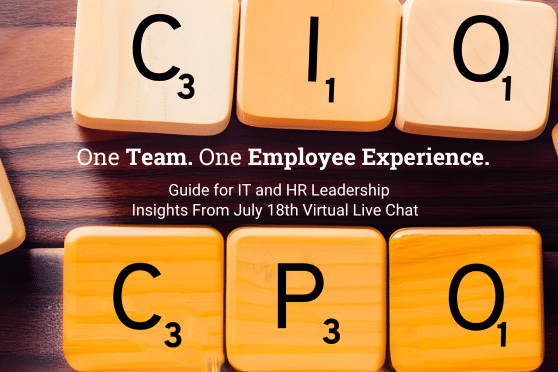“One Team. One Employee Experience.” isn’t just a slogan but a guiding principle for HR & IT leaders in achieving Digital Employee Experience (DEX) excellence. In our exploration of DEX strategy, I had the privilege of conversing with three industry professionals at the forefront of digital transformation. John Adcock, Chief People Officer at Eventbrite, Mindy Honcoop, a distinguished People Leader, and Vlad Temnov, the Chief Information Officer (CIO), offer unique insights into DEX strategies, key stakeholders, crucial funding and ROI considerations, and the indispensable HR-IT partnership in the realm of AI and DEX. Join us as we delve into the future of employee experience through the eyes of these visionary leaders.
Evolution of HR and IT Leadership in the Digital Age: Meet John Adcock, Mindy Honcoop, and Vlad Temnov
In a dynamic world where the workplace is constantly evolving, HR and IT leaders play pivotal roles in shaping the future of organizations. Today, we introduce three remarkable individuals who have been at the forefront of this transformation: John Adcock, Chief People Officer of Eventbrite; Mindy Honcoop, People Leader; and Vlad Temnov, Chief Information Officer. Each of them has navigated their roles through significant changes in recent years, driven by the digital revolution. Let us take a closer look at how their roles have evolved and what makes them unique.
John Adcock – Chief People Officer, Eventbrite
John Adcock’s journey as Chief People Officer at Eventbrite reflects the seismic shift that remote work has brought to the workplace. He paints a picture of Eventbrite’s transformation, where the organization’s once predominantly U.S.-focused operations have now expanded across the globe. John’s challenge is to bridge the gap between the digital and analog realms of work and collaboration. John is now intricately tied to the digital infrastructure that enables remote work, creating a work environment that fosters productivity and engagement, regardless of location.
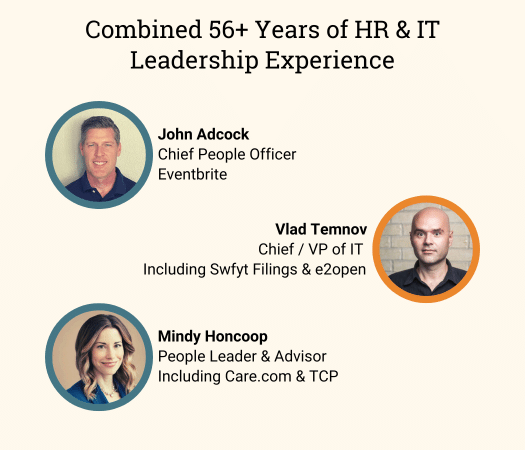
Mindy Honcoop – People Leader
Mindy Honcoop’s role as a People Leader has seen her transform the HR function from a reactive state to a proactive one. Mindy’s enthusiasm for innovation shines through as she shares stories of even traditional sectors like manufacturing going paperless. Her ability to envision and execute change has breathed new life into small and medium-sized businesses, turning them into hubs of innovation.
Vlad Temnov – Chief Information Officer
Vlad Temnov’s quest to reduce the time required to make sourdough bread might seem unrelated to his role as Chief Information Officer, but it underscores his commitment to efficiency and optimization. In a world grappling with communication fatigue, he has sought the right balance between mobility, security, and privacy. His work is about creating an environment where employees can communicate and collaborate effectively across time zones and geographies.
Navigating the Future Workplace Experience
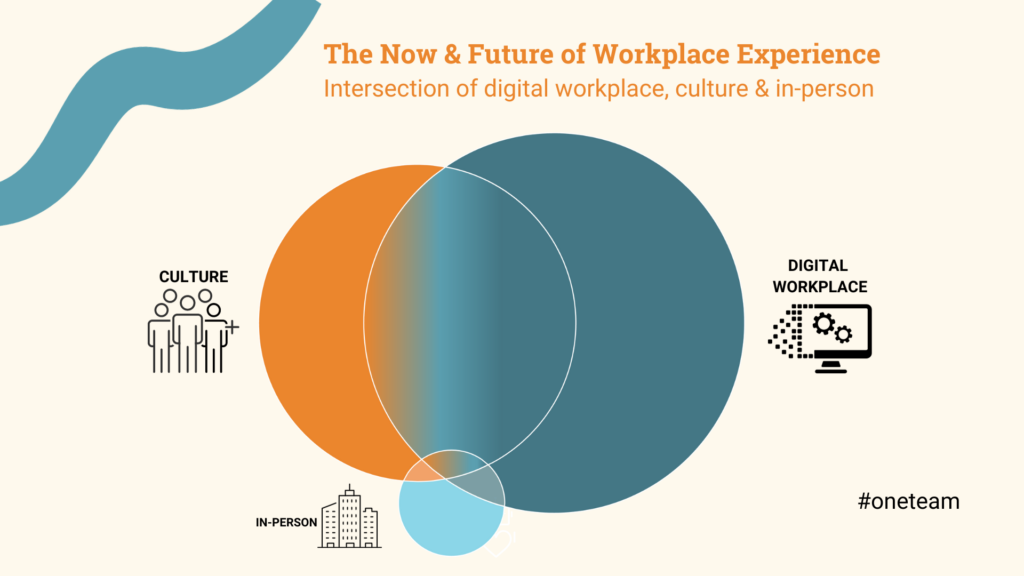
Today’s workplace experience is an intricate blend of digital, cultural, and in-person elements, undergoing a dramatic evolution explored by HR and IT leaders. The digital workplace has surged to prominence, notably due to widespread remote work. Beyond mere connectivity, it’s about cultivating a thriving digital ecosystem that promotes cross-boundary collaboration and engagement. Organizational culture has undergone a profound shift, enabling real-time innovation and adaptation through new working methods. Despite the challenges posed by remote work, the human element remains paramount. In-person interactions, though altered, retain their significance, prompting companies to reimagine their integration into the workplace. Striking the optimal balance between digital, culture, and in-person dynamics will define the future workplace experience, a journey characterized by continuous change and innovation steered by agile HR and IT leaders.
Defining the Digital Employee Experience (DEX)
Vlad, John, and Mindy revealed compelling perspectives on what this transformative concept means to their businesses and employees.
Vlad emphasized the uniqueness of each company’s DEX strategy, shaped by factors like size, location, and industry. He underscored the importance of addressing organizational pain points and the need for a seamless onboarding experience. Efficiency and corporate efficiency emerged as key values, with Vlad highlighting that a smooth employee experience often translates into higher employee satisfaction and longevity, a significant win for companies. To drive and centralize this experience, Vlad suggested the creation of dedicated task forces within organizations to test and implement DEX initiatives.
John shared a holistic perspective. He emphasized that DEX should be viewed in the same light as any other employee experience, focusing on problem-solving and ease of use. He stressed the importance of human-centered design, championing an approach that understands the day-to-day experience of employees. John highlighted that the digital aspect of DEX is an enabling factor within the broader employee experience, encompassing tools, processes, and people necessary for employees to accomplish their tasks, learn, develop, and grow.
Mindy extended the discussion to the customer-employee interaction dynamic within the DEX ecosystem. She emphasized the importance of assessing how technology solutions align with customer success and employee performance. Mindy pointed out that technology should not merely solve processes but should enhance the employee’s interaction with customers, thereby improving overall satisfaction. The discussion converged on the idea that a happy workforce correlates with delighted customers, highlighting the interconnectedness of customer and employee experiences.
Unraveling the DEX Stakeholder Landscape
Identifying the key stakeholders is crucial for success.
Mindy pointed out the essential partnership between the Chief Information Officer (CIO) and the Chief People Officer (CPO). While the CIO brings a process-centric view rooted in technology, the CPO lends a critical human perspective by gauging employee feedback and assessing how technology initiatives impact the workforce. The desire for both these leaders to understand and speak each other’s language is pivotal. Furthermore, Mindy highlighted that key stakeholders also encompass the executive team, leadership, and management, who play pivotal roles in driving and implementing change initiatives.
While Vlad emphasized that stakeholders come from various roles within the organization and bring unique perspectives based on their positions and experiences. They not only influence decision-making but also contribute insights into the organization’s needs and pain points. Moreover, stakeholders can be instrumental in budgeting for initiatives, prioritizing them, and ensuring successful adoption throughout the organization. Vlad aptly mentioned that while identifying the right technology solutions is crucial, driving adoption is equally vital, as even the best technologies can falter without widespread usage.
Insights from HR and IT Leaders on DEX Ownership
The question of who owns Digital Employee Experience (DEX) in organizations sparked intriguing conversations among HR and IT leaders. Most respondents indicated that DEX ownership should be a collective effort, with “all of the above” emerging as the popular choice. Interestingly, only a small percentage attributed sole ownership to IT.
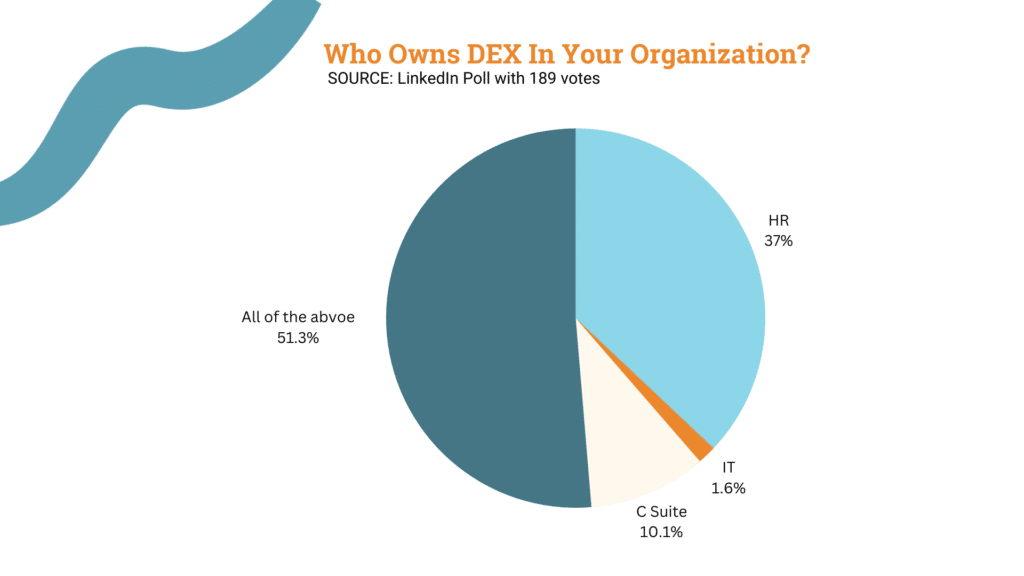
Mindy highlighted the common scenario where DEX ownership can feel like a passing of the baton, with multiple stakeholders unsure of who should lead. She stressed the importance of establishing a clear and accountable owner who collaborates with various teams to ensure outcomes align with the organization’s goals. This clarity helps in measuring ROI and defining roles and responsibilities.
John and Vlad agree the best approach to DEX ownership is a collaborative one, where HR, IT, and other departments work together. Both noted that user engagement and leadership involvement are crucial components of DEX, emphasizing that leadership’s visibility and engagement in tools and processes have a significant impact.
Unlocking Digital Employee Experience (DEX) Investment: Strategies for Funding, Prioritization, and ROI
The process of funding, budgeting, and prioritizing Digital Employee Experience (DEX) initiatives is a pivotal facet of enhancing workplace engagement.
Vlad and John emphasized the importance of aligning DEX initiatives with the overall organizational strategy. Vlad pointed out the significance of selling these ideas to executive leadership, emphasizing that collaboration with top decision-makers is essential. Timely planning within the budgeting cycle was highlighted as a key factor, as it ensures adequate funds are allocated for DEX improvements.
John underscored the necessity of managing DEX initiatives like products, identifying core issues, and addressing them based on importance and impact. He stressed the value of data in decision-making, citing the importance of tracking employee inquiries and feedback as a compass for prioritization.
Mindy explained the need to start with a clear understanding of the current state through auditing processes and baseline assessments. She emphasized that organizations must determine how DEX improvements align with their business strategy. Mindy pointed to the ROI indicators, including employee sentiment, talent attraction and retention, and customer experience. Connecting the dots between employee and customer experiences can reveal greater customer retention and align with overall business goals.
Bridging the Gap Between Strategy and Metrics in DEX Budgeting
In a recent conversation, a notable highlight was the discussion around a valuable framework, emphasizing the hierarchy of metrics, which aids in connecting technology investments with business strategies.
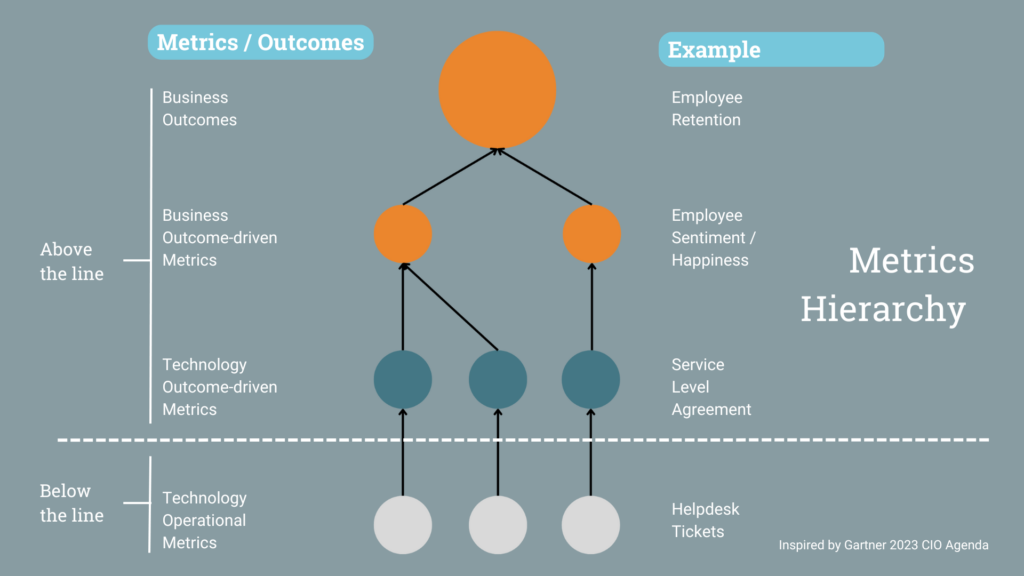
The framework starts with the top-level consideration, the business strategy, and the desired outcomes. From there, it drills down to the next level, identifying attributes that can help predict and drive specific outcomes, such as employee retention. Finally, it delves into technology-driven metrics that support the level above, aligning with the overarching business goals.
Building Synergy: How IT and HR Can Collaborate on the AI and DEX Journey
IT plays a pivotal role in the initial stages, offering its analytical prowess to gather corporate insights and feedback, essential for identifying pain points and needs within the organization. By collaborating closely with HR, IT can aid in the analysis of these insights, thereby shaping a roadmap and action plan for the DEX journey. This analytical approach serves as a catalyst for initiating the process and overcoming the initial inertia.
On the other hand, HR holds the key to understanding the pulse of employees, being their primary point of contact. HR’s deep insights into employee needs and preferences can significantly contribute to AI and DEX strategies. HR can also support IT by fostering a culture of comfort and openness towards AI, demystifying it as a tool rather than a threat. Collaborative brainstorming sessions between HR and IT can lead to innovative ideas on how to leverage AI for enhancing the employee experience.
Additionally, both IT and HR should strive to bridge the communication gap and foster an inclusive environment. By recognizing each other’s strengths and knowledge domains, they can create an integrated approach to AI and DEX, driving the organization toward a more agile, experimental, and innovation-driven culture. The harmonious collaboration between IT and HR is the cornerstone of a successful AI and DEX journey, aligning technology initiatives with human-centric strategies.
Three Take-a-Ways for HR and IT Leaders
Amplifying Employee Experience, Fostering Collaboration, and Aligning Strategies
To excel in the evolving realm of HR and IT leadership, three core priorities emerge. First, recognizing the symbiosis between customer and employee experiences is crucial. Mindy Honcoop highlights how technology can enhance these interactions, underscoring the significance of prioritizing DEX initiatives that boost employee satisfaction and fortify customer relationships, thereby fueling business success. Second, adopting a collaborative DEX ownership approach, championed by John Adcock, is pivotal. This shift from siloed responsibilities to a unified vision should be a top priority, ensuring DEX initiatives harmonize with organizational goals, amplifying their impact. Lastly, aligning DEX endeavors with the broader organizational strategy, as emphasized by Vlad Temnov and John Adcock, is key. Readers should prioritize this alignment to secure the resources needed for fostering an innovative and adaptable workplace ecosystem in the digital age.

